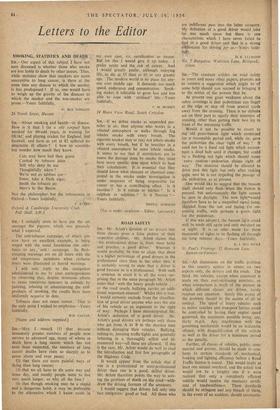SIR,—The constant articles on road safety in yours and many
other papers, prompts me to venture a suggestion which might he of some help should you succeed in bringing it to the notice of the powers that be.
At present one great weakness' about the zebra crossings is that pedestrians can linger at the edge or step off from several yards away from the crossing. There is no definite act on their part to signify their intention of crossing, other than putting their best leg in front of the oncoming traffic.
Would it not he possible to revert to the old press-button light which continued for a' reasonable period and, while on. gave the pedestrian the clear right of way '? It need not be a fixed red light which necessi- tates a dead halt until it changes, blit could he a flashing red light which should mean ' extra caution—pedestrian claims right of way.' The motorist should be allowed to drive past this light but only after making quite sure he is not impeding the passage of the pedestrian, as at present.
One would like to suggest that the beacon itself should only flash When the button is pressed, but unfortunately the light cannot be seen in daylight. The new light•would therefore have to' be a magnified signal lamp, shielded from the sun and facing the on- coming traffic, with perhaps a green light for the pedestrian.
If this was adopted, the beacon light could well be made still ag.tin and only switched on at night. It is an utter waste for these thousands of lights to he flashing all through the long summer days. -Yours faithfully. E, J. HAY HICKS St. Paul's Vicarage, 32 Hawcoat Lane.
Barrow-in-Furness


































 Previous page
Previous page